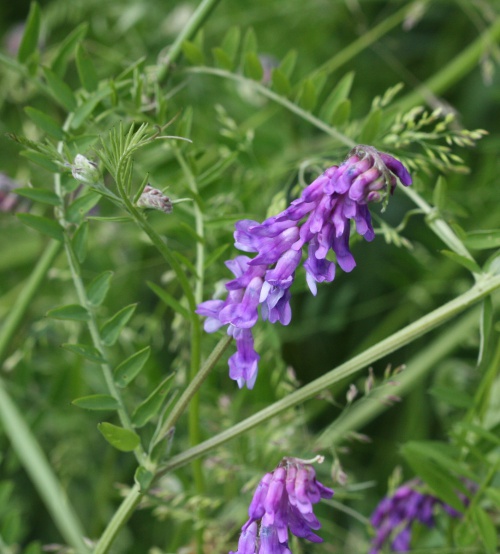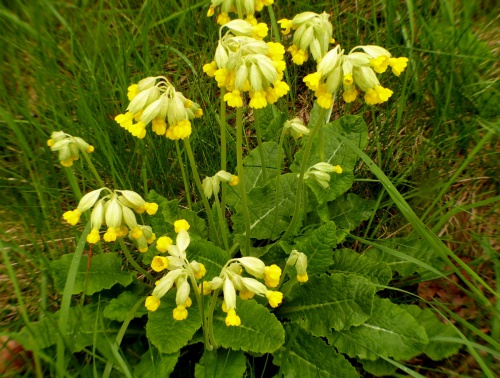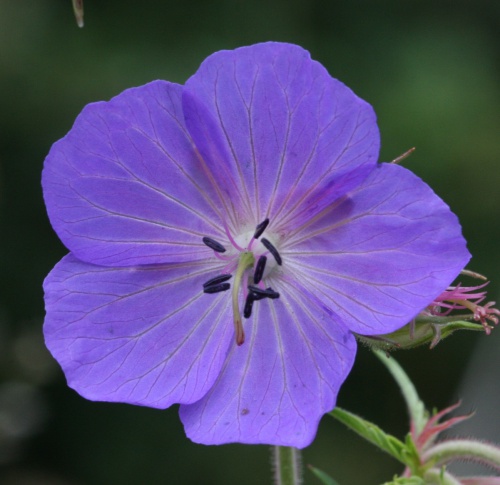
These narrow meadow verges along Ferndale Drive were created from seed when the estate was built. They are now part of the County Council/Parish Council verge wildlife project and are mown only in September to allow the plants to grow and flower. All the species shown here are just a selection of those that have been recorded on the verges. Visit the NatureSpot webpage featuring these verges for a full list and more information. Click on any header to visit the NatureSpot page for that species to find out more.
Wildflowers
The wildflowers and grasses are the heart of the wildlife habitat, providing food, cover and breeding opportunities for a wide range of species. Here are 6 of the most colourful wildflowers to be found on the Ratby verges.
Oxeye Daisy
White petals with a yellow centre. Typically grows to around 60cm and flowers May to September. Commonly included in wildflower seed mixes. Attractive to butterflies, bees and other pollinators.
|
strap-shaped leaves |
Common Knapweed
This is a classic meadow flower, found in most quality grassland habitats. It is a rich nectar source for many insects and also supports numerous invertebrates that only feed on knapweeds.
How to ID: Pink/purple thistle-like flowers, typically growing to 80cm (June to September).
Where to see it: Meadows and verges.
Similar species: Greater Knapweed is much larger, has deeply lobed leaves and long, frilly petals.
Tufted Vetch
Blue-violet pea-like flowers from June to August/September. The plant clambers over other vegetation, gripping with tendrils at the end of each set of paired leaflets.
Meadow Buttercup
The 'classic' meadow buttercup, growing to around 60cm.
How to ID: Typical yellow buttercup flower. Leaves are deeply divided and resemble large green snowflakes!
Where to see it: Established meadows.
Similar species: Creeping Buttercup (3 leaflets in a triangle) and Bulbous Buttercup (downward pointing sepals under the petals).
Cowslip
The yellow flowers appear in April-May, held on a short stalk with up to 30 individual flowers clustered on one side. A favourite with bees as a valuable early nectar source.
Meadow Cranesbill
The large violet-blue flowers make this a stunning plant. It flowers from June-September and has round, but deeply divided, leaves.


Insects
As the verge is allowed to grow as a wildflower meadow, many insects have moved in. Butterflies, moths and bees can be seen as they visit to feed on nectar, but beetles, bugs and other wildlife can also be found deeper in the vegetation. Here are 4 species spotted on the Ratby verges.
Six-spot Burnet
This beautiful day-flying moth flies from June to August and breeds mainly on Birds-foot Trefoil.
How to ID: Black with red stripes and spots on the forewings and all red hindwings.
Where to see it: It is a day-flying moth and can be found feeding on flowers such as Knapweed.
Similar species: Narrow-bordered 5-Spot Burnet (5 wing spots)
Ringlet
This dark brown butterfly gets its name from the small rings on both the upper and lower surfaces of the wings. Males are darker with smaller rings. It breeds on various meadow grasses.
How to ID: Dark brown with a white fringe. Small 'ring spots on all wings, both sides.
Where to see it: Meadows, verges, woodland rides - late June-August.
Similar species: The Meadow Brown is also dark brown but just has one eyespot on each upper wing.
Tortoise Beetle
This flattened beetle is golden-green with a darker central stripe. It is found on thistles and Yarrow where it hugs the leaves and stems for protection.
Hairy-footed Flower Bee
This is one of the first bees to appear in Spring and flies from March to May. The black females are very different to the brown furry males but both have long tongues to reach into trumpet-shaped flowers such as White Dead-nettle. In gardens they love Lungwort (Pulmonaria). They nest individually in holes.









